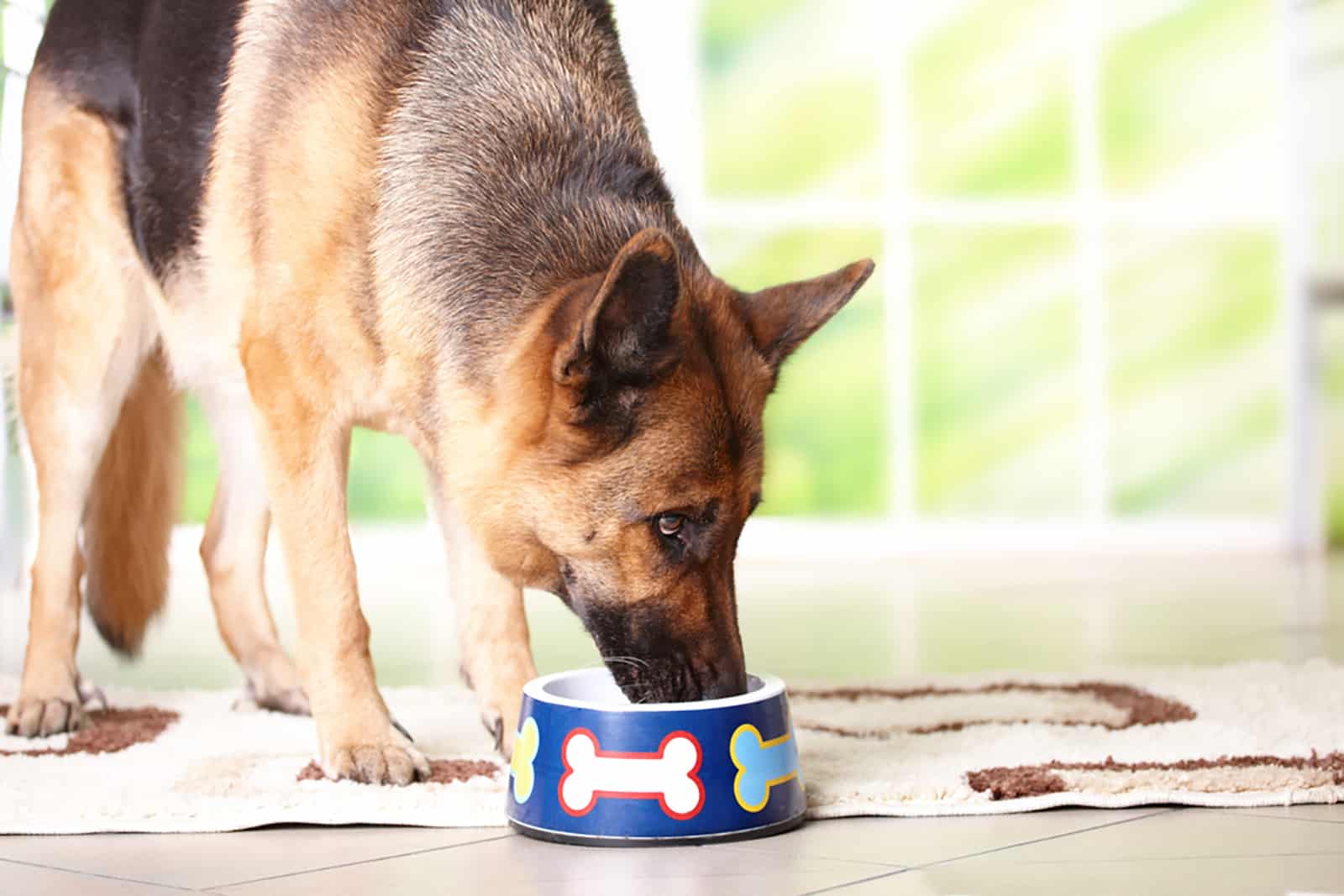The German Shepherd feeding chart is a great tool for all GSD owners (current and future) who are looking for ways to keep their pets happy and healthy with proper eating habits.
German Shepherds are amazing canines and they’re great family pets. These pups rarely show any signs of aggression, and even if they do, it might be related to hunger or a feeling of threat.
Blue, black, white, Isabella, sable, or silver, these pups will steal your heart in whichever shape or color they come in! GSDs are such great pups you will almost forget how much they can bark (but that doesn’t happen all the time!)
As one quote about GSDs says, “Nobody is perfect, but with a German Shepherd, you’re damn close.”
Well, it’s time to learn how to keep your almost perfect pup in the best shape possible by looking at this German Shepherd feeding chart!
German Shepherd Feeding Chart By Age
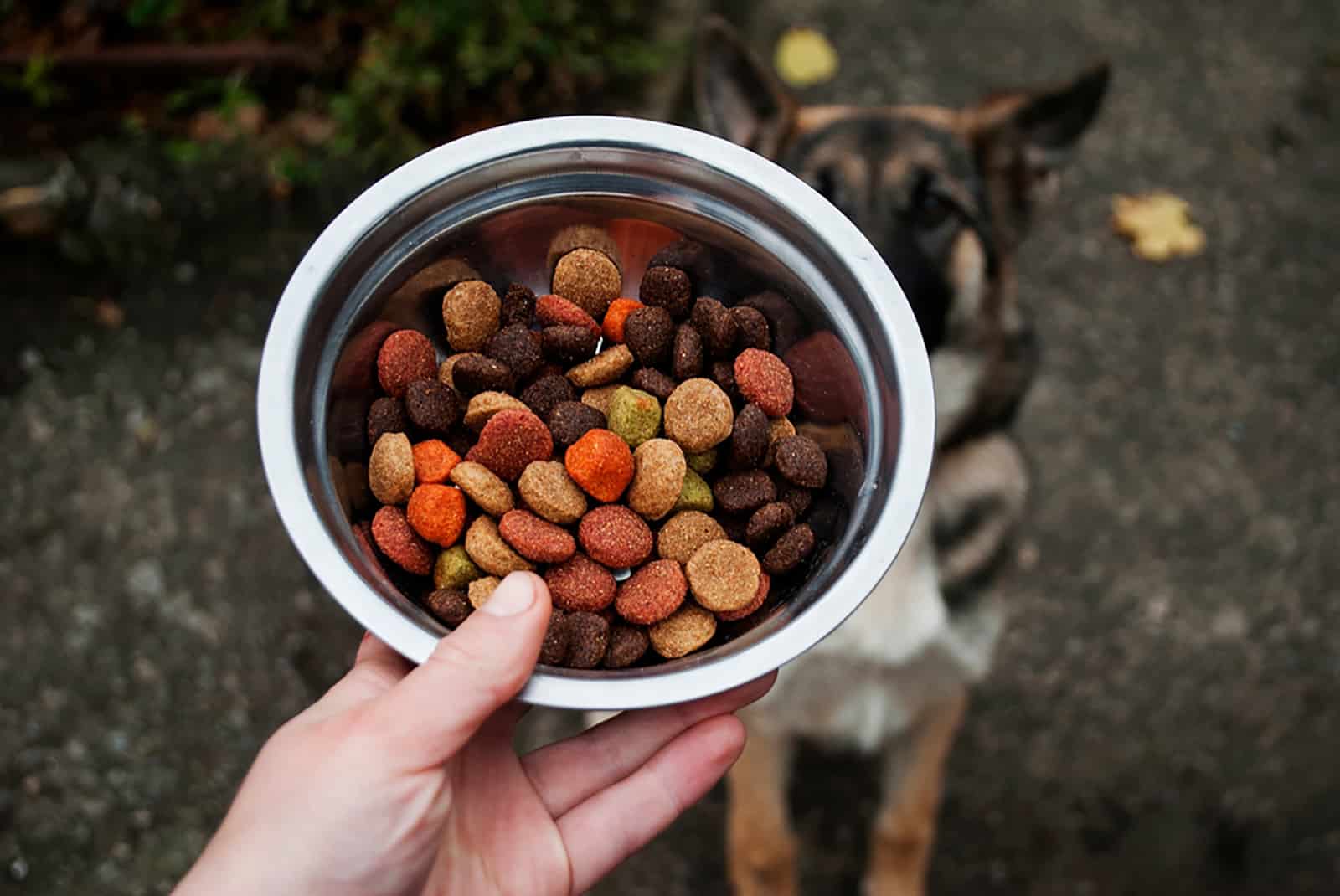
[table id=546 /]
These are general guidelines for a GSD’s feeding schedule and can be adjusted depending on the activity level of each individual canine.
A doggie with lower energy levels will require a lower calorie intake, while a highly energetic pup will require a more caloric diet.
That is why this German Shepherd feeding chart should be used more as a general recommendation, not as a strict pattern you need to follow.
Following the needs and requirements of your pet is crucial for the dog’s health, and the best way to keep your puppy healthy is to find and stick to its own eating routine. This may or may not be the same as the one written in the chart above.
However, there is a certain pattern that needs to be followed, no matter how much food your pup eats.
Every German Shepherd should receive their food at the same time every day. If you notice that your pup hasn’t touched its food, you can try again after fifteen minutes.
If nothing changes, try again an hour later. If your pup still refuses to eat, it might be time to visit the vet and check their health.
German Shepherd Puppy Feeding Chart (First 2 Months)
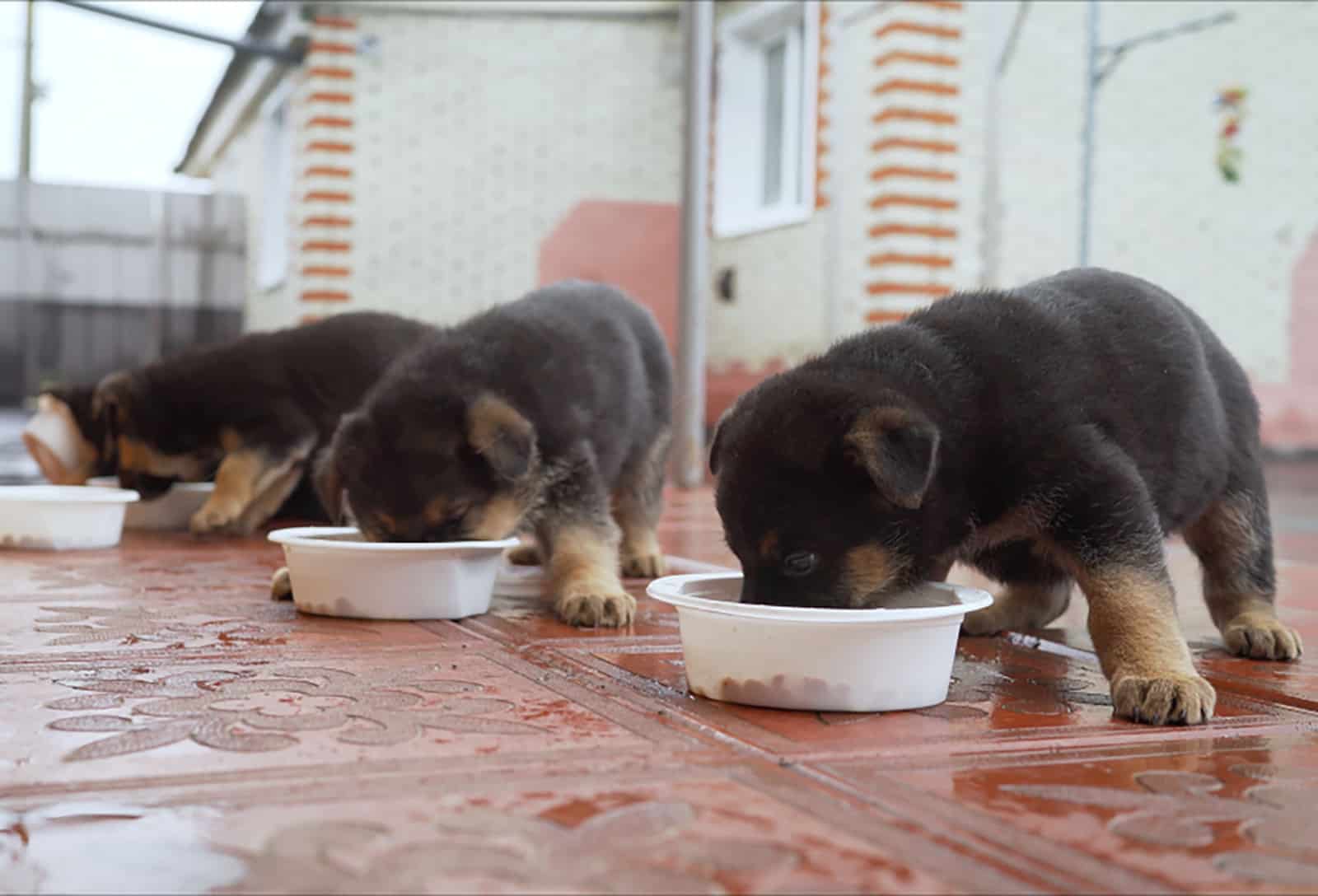
During the first two months of their lives, German Shepherd puppies should remain with their mothers, as this is the period during which they receive all the essential nutrients from their mother’s milk.
First Four Weeks Of Life
Breeders and dog owners usually don’t have much work to do for the pups during the first few weeks of their lives.
Their mother is their main source of food for the first month of their existence until the puppies lose all their puppy teeth.
As soon as they start teething, the mother will feel uncomfortable and start the weaning process by themselves, without the help of their owners.
You can try to encourage the female German Shepherd to continue nursing for a certain period of time, but if you notice that she’s in great discomfort, you can help her by offering puppy mush instead of mother’s milk.
Puppy mush is essentially a mixture of dry dog food with a replacement for the mother’s milk (i.e. formula) or water.
Since one-month-old puppies don’t have teeth strong enough to chew kibble, they need their food to be softened as much as possible.
The Second Month Of GSD Puppies’ Lives
Puppies begin to investigate their surroundings as soon as they pass one month of age.
Although breastmilk should serve as their primary source of nutrition, now would be a good time to attempt to introduce the pups to puppy food.
The puppy food (puppy mush) should be made out of 1/4 food mixed with 3/4 water, as their stomachs still aren’t prepared for large amounts of food.
Also, if you’re adopting a German Shepherd pup, it should be at least eight weeks of age.
Make sure to get the same puppy food that the breeder used, at least for the first few weeks, until they get used to the new environment.
German Shepherd Puppy Feeding Chart (3 To 6 Months)
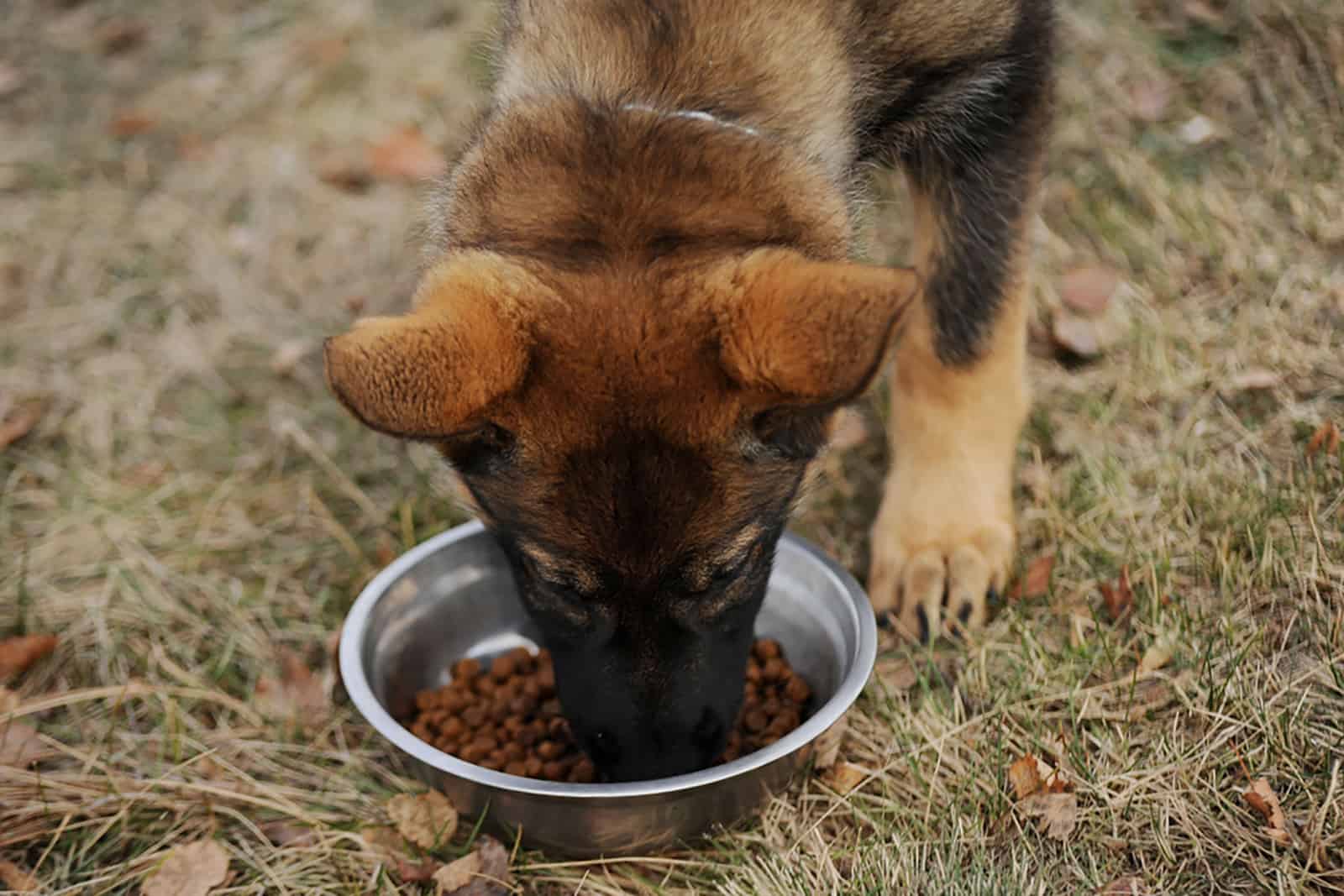
A growth spurt might occur just before the puppy turns three months of age, so don’t be surprised if your pet’s appetite increases suddenly.
It’s important to set their feeding schedule during the third and fourth months of the pup’s life to establish healthy eating habits and prevent your pup from being overfed.
Even if you shouldn’t restrict their eating too much at this age, it’s also not a good idea to give them free rein over the kitchen and let them gorge themselves whenever they want to.
The parents of large breed pups frequently give in to their puppies’ demands for more food, which might lead to the puppies developing a weight problem later in life.
How Can I Know When It’s Enough?
First of all, you can follow the German Shepherd feeding chart and stick to the feeding schedule recommended for the age of your puppy.
Don’t let those puppy eyes fool you into letting them devour half of a bag of kibble just because your pet craves it.
If you notice that your pup is really hungry after having a meal and that the scale shows little to no improvement, you can add about half a cup more to each meal.
However, I’d still recommend you visit the vet if your pup has constant hunger and begs for food. There might be certain medical issues behind it.
Also, the vet will give you advice on feeding your pup based on examination results rather than assumptions of what might or might not be right.
Keep an eye on the weight, form, and shape of its body. You are able to cut back the number of feedings to three per day when your four-legged companion begins to take on the appearance of an older puppy, and the potbelly starts to diminish.
German Shepherd Puppy Feeding Chart (6 To 12 Months)
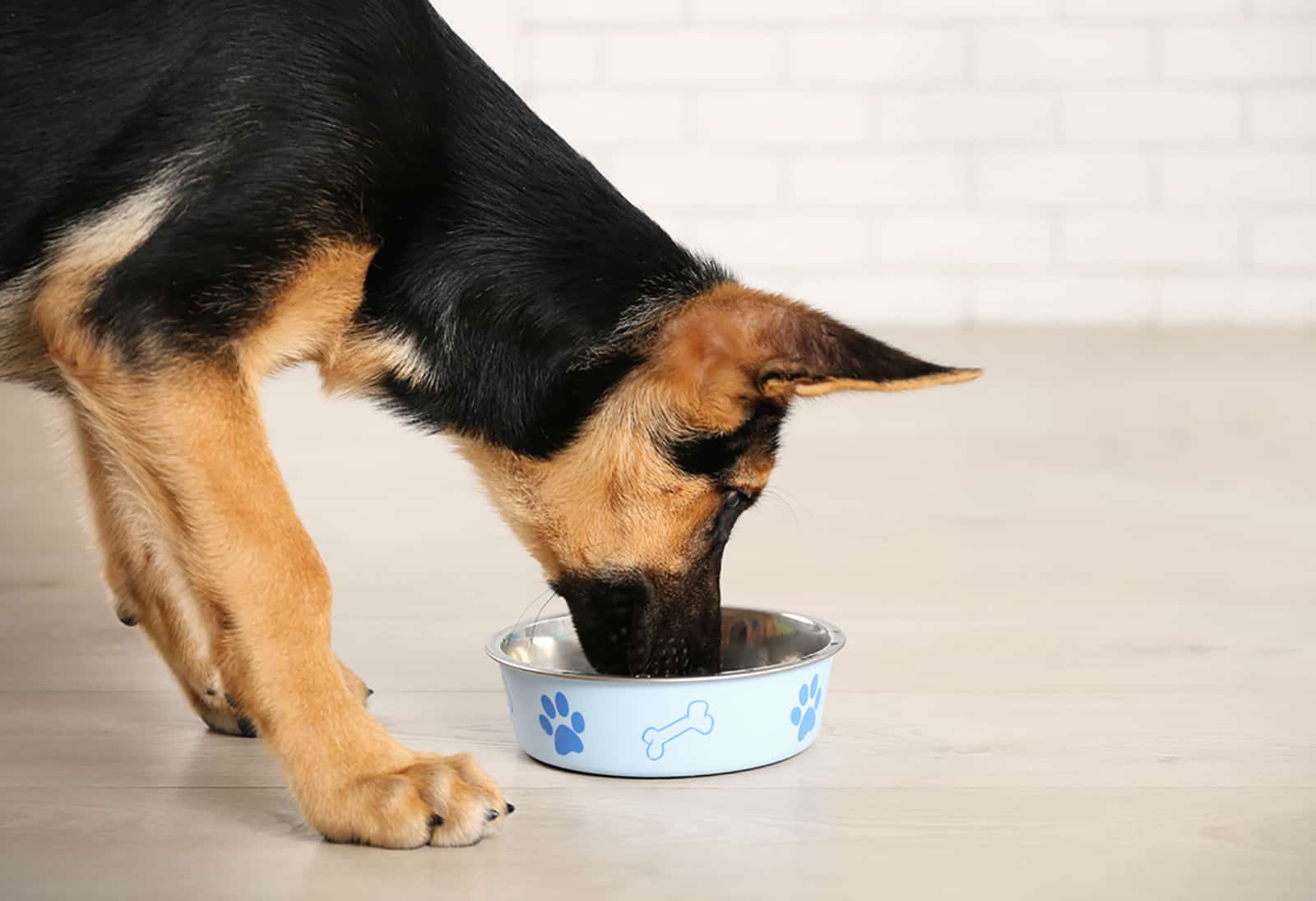
The German Shepherd doggie will continue to develop during this period, but it’ll be a significantly slower process than during the first six months of their lives.
As the puppies are getting closer to their first birthday, their diet will require lower calorie intake, so you can reduce the number of meals during the day down to two meals (three at most, if you think that’ll benefit your pet more).
However, you’re still obliged to regularly monitor your pup’s development by keeping an eye on its weight, health, and level of physical activity.
Most dog owners find a smaller number of meals more beneficial for their pups as they receive the same number of calories with lower chances of feeling hungry at any particular time during the day.
When Should You Introduce Adult Dog Food?
Even though your canine companion should still be consuming puppy food during this stage, you may want to think about getting them adult dog food.
Some owners introduce adult food through treats and training prizes, which is just enough to get them accustomed to its distinctive texture and taste.
On the other hand, some owners decide to mix kibble for adult canines with puppy food in different ratios until the latter is completely gone from their menu.
The transition usually begins somewhere around the tenth month of age, but you won’t be late if you start when your pup turns one.
Before making any adjustments to the food your GSD eats, you absolutely have to consult with your veterinarian first.
Your vet is the only one who can tell you when your dog has achieved maturity and when it is safe for you to switch them over to adult food.
German Shepherd Feeding Guide For Adult Dogs
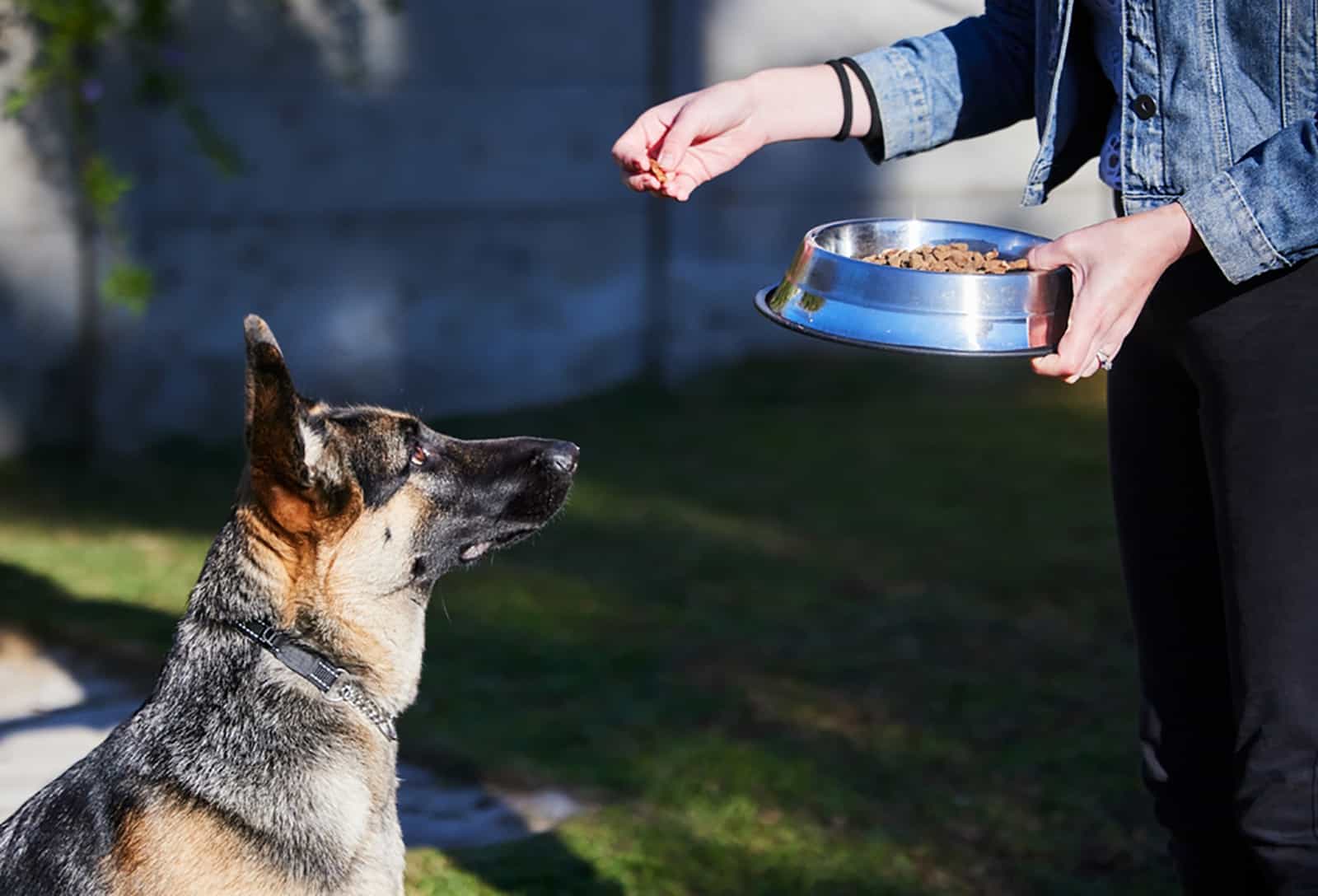
Congratulations, your pup is now officially a young adult canine that is ready for all sorts of adventures, be it outside or inside the house.
This period of your canine’s life is usually marked by a high level of physical activity, considering that German Shepherds are working dogs who often spend a lot of time in the field as the right paw of military and police forces.
That’s why it’s essential for them to be fed a balanced diet, even if they’re raised as family pets.
These pups simply love to be active and they love training, as well as dog parks or any other places they can run around freely.
The proportions of calcium, protein, and phosphorus, along with the other ingredients, in adult dog food will be different from those found in puppy food.
What If I Feed My Adult German Shepherd Puppy Food?
Essentially, offering puppy food to your GSD once in a while won’t do huge damage, but if it’s not necessary, there’s no reason to do it.
The dog will not get any benefit from it; actually, quite the opposite will happen if it becomes a regular routine.
If you feed an adult canine this type of food, you run the risk of your pet becoming overweight and putting an unnecessary burden on their kidneys and other essential organs.
Consuming food filled with calories to a dog that has already reached its full grown size will only result in an obese pup with a high risk of health problems.
The main reason why dogs are offered different types of food during different stages of their lives is to attend to the specific needs and requirements of German Shepherds.
German Shepherd Feeding Guide For Senior Dogs
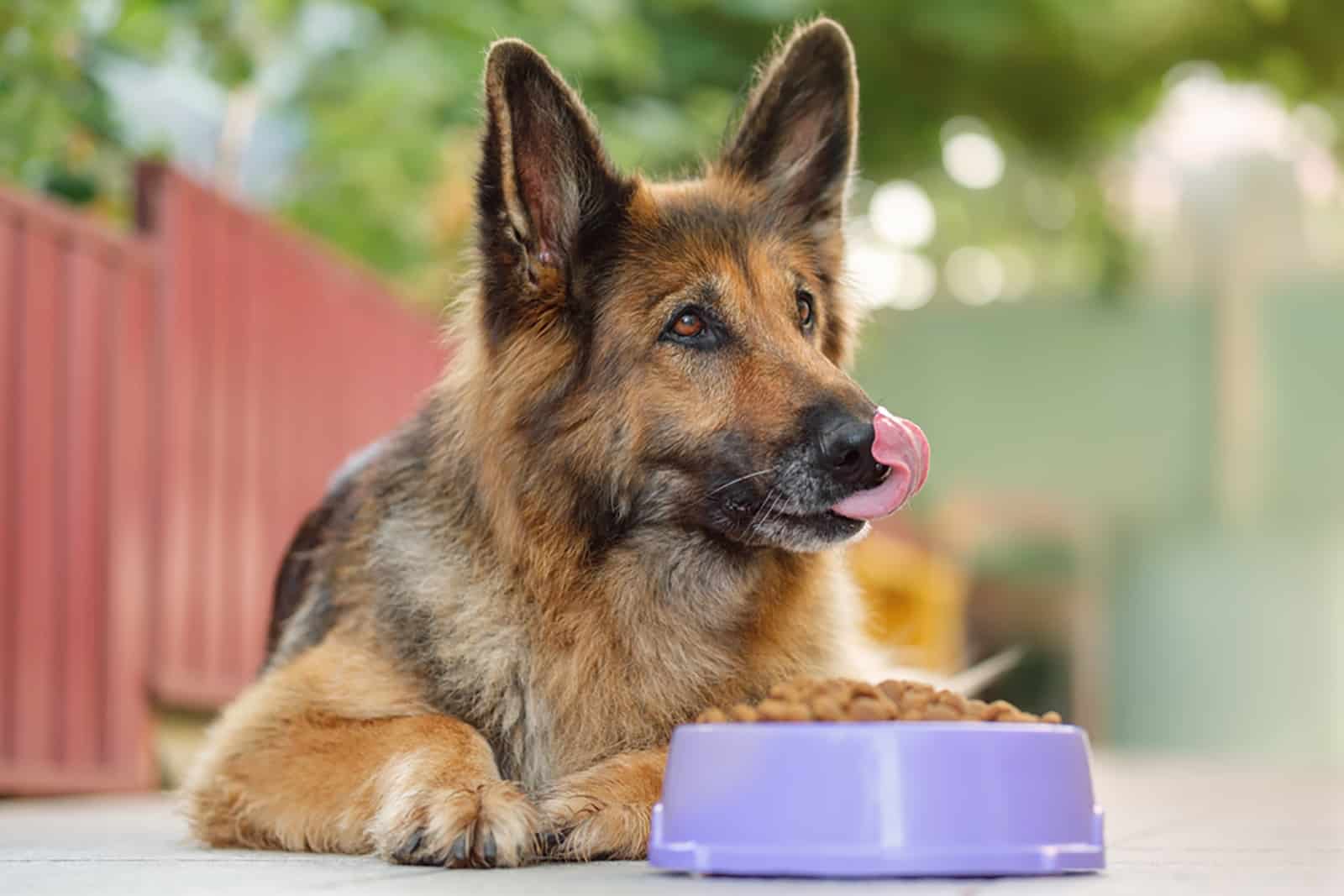
Unfortunately, the lifespan of large breed canines, including German Shepherds, Rottweilers, and Cane Corsos, isn’t as long as the life expectancy of smaller breeds like Chihuahuas and Shih Tzus.
That is why GSDs might seem to enter their senior years earlier than expected, around the seventh year of life.
However, their age isn’t the only sign of entering the senior phase of life.
Most German Shepherds go through certain changes in their bodies during this period which leaves a negative impact on their general well-being, as well as the health of their bones, joints, and muscles.
As I mentioned, GSDs are fiercely energetic, but as the years pass by, their activity levels might begin to drop. That is why senior GSDs need to have certain adjustments made to their menu.
Because of this, it is essential to pay attention to the indicators of aging in your pet if you want it to live a long and happy life.
When Should Your Pup Switch To Senior Dog Food?
As soon as your doggie starts showing signs of growing older, it’s time to slowly introduce them to senior food, which contains all essentials for an older dog’s health, but with a decreased number of calories.
Still, it would be better to consult with your vet about whether or not you should make any adjustments to the canine’s diet at a certain time or whether or not it is acceptable to continue feeding them the typical adult meals.
Because larger adults also have a tendency to slow down their digestion, choosing a diet that is higher in fiber for your senior GSD can be a smart idea.
Due to the fact that the number of calories included in senior-specific dog food has already been adjusted, it is probable that you will continue to feed your GSD the same measured quantity depending on its weight.
What Types Of Food Should Senior Canines Avoid?
Senior German Shepherd dogs can struggle to tolerate any food or dog treats that are heavy in fats or salt, as well as dog biscuits that are high in calories.
Instead of offering these, you might try giving an old German Shepherd nutritious treats like fruits (apples) and veggies. This will keep them healthy and happy.
Unfortunately, there are plenty of senior canines who are in need of additional care because of health issues that are the result of their age and poor nourishment.
The nutritional needs of older GSDs are different than in young adult canines, which some people overlook.
Therefore, although they have good intentions, owners usually overfeed their senior doggies or simply offer them food that isn’t suitable for the dog’s age and health concerns.
But there’s no need to worry, it’s never too late to put your GSD on a diet that is nutritious, low in fat, low in salt, and high in nutritional density.
A German Shepherd’s diet can have an even more significant impact on the quality of life of GSDs who suffer from health conditions such as joint pain or kidney issues.
What Is The Recommended Daily Amount of Food For A GSD?
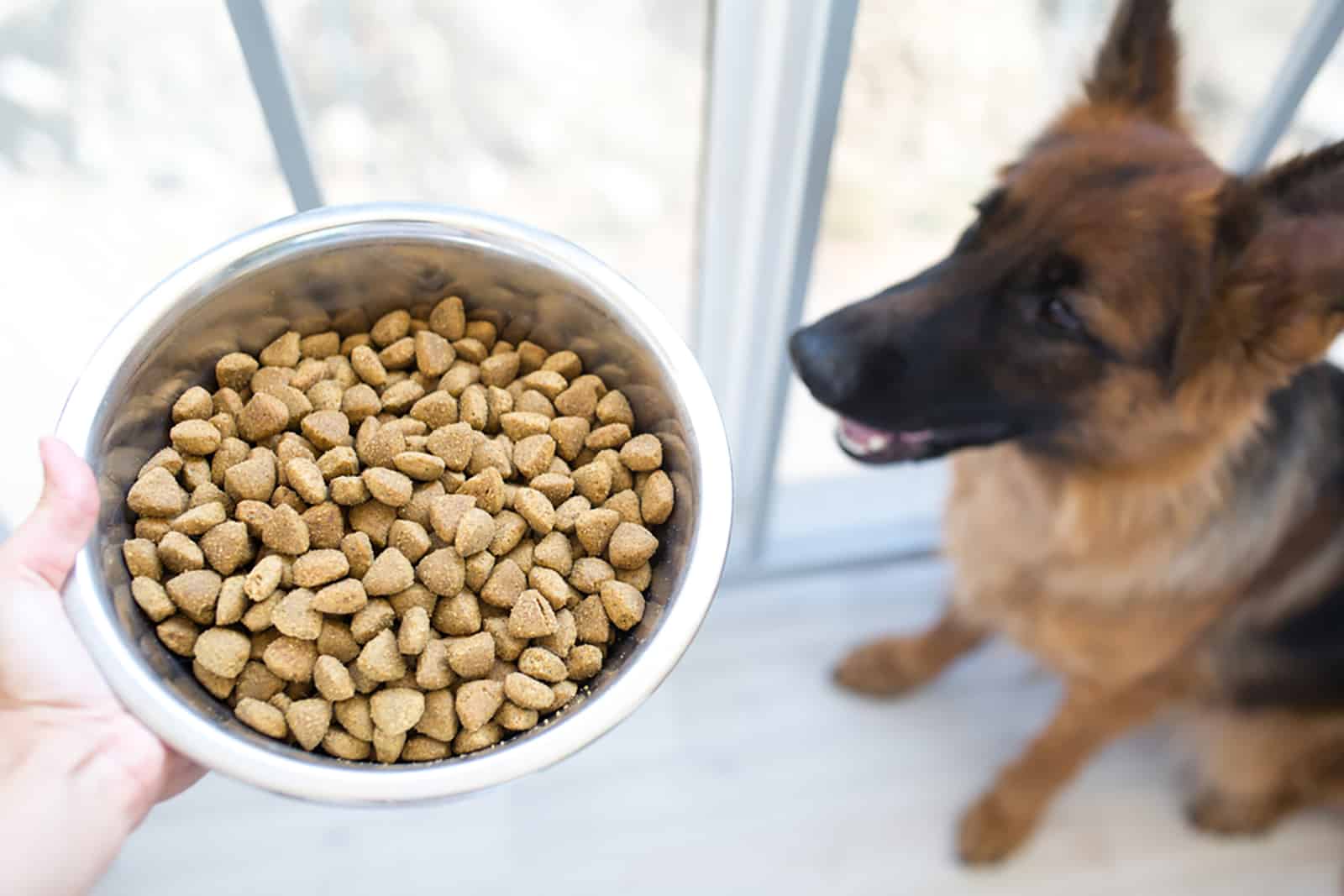
Generally, it can be said that adult German Shepherds require 2100 calories per day at most. Anywhere between 1300 and 2100 is considered an acceptable amount, depending on how big and active the canine is.
Calorie intake is usually based on the age of the canine, their current health condition, and the quantity of exercise they get.
In order to keep a healthy and steady weight, senior German Shepherds that aren’t very active won’t need more than 1300 calories on a daily basis.
On the other hand, active dogs, even in their senior years, will require up to 1700 calories per day.
That is why it’s important to monitor your pet’s weight, level of activity, and overall well-being.
Always keep in mind that it’s better to consult with a health professional and receive feeding guidelines according to your pup’s state if you’re not sure about the amount of food they should have.
What Is The Recommended Amount Of Food For A GSD Puppy?
Unlike adult canines, puppies require twice as many calories per pound of weight, which is why German Shepherd puppy food is mostly based on calories.
Therefore, in order to keep up a healthy rate of growth and development, these large breed puppies should have a higher food intake than their senior relatives.
Some owners doubt whether their puppies’ diet should include so many calories, but consumption is the only way to keep the pups healthy and encourage their growth.
In order to achieve optimal growth and development, a puppy that is less than four months of age would require between 80 and 90 kcal per pound of weight on a daily basis.
After a GSD reaches the age of four months, its calorie intake can be decreased to between 40 and 60 kcal per pound of weight.
Basically, this indicates that a two-month-old GSD puppy eats twice as much food as an adult canine.
You should measure your pup on a regular basis, monitor their general health, and alter the amount of food they eat so that it can support their development.
Why Do They Need So Much Food?
German Shepherd pups have high energy levels and are way more active than adult (especially senior) GSD dogs. They also grow significantly larger during the first months of their lives.
That is why their need for calories and proper nutrition increases during that time until the pups reach their full growth.
German Shepherds are big dogs who love spending time outside, which is why they need a lot more energy than small breeds such as French Bulldogs, Shih Tzus, or Yorkies.
The main source of energy for both GSD puppies and adult dogs is food, especially for youngsters.
A puppy’s diet should be filled with calories and healthy fats, which enable them to become strong and agile GSD adult canines.
A significant number of pups have a requirement for an increased caloric intake just prior to experiencing a growth spurt, and then they consume somewhat less following the growth surge.
Keep in mind that the amount of calories in various brands and manufacturers’ products varies substantially.
When purchasing food for your GSD, you should always check the nutrition label as well as the nutritional advice that comes with the container.
How Can I Know Which Amount Is Suitable For My Pup?
The best way to know how big a meal should be for a GSD puppy is to measure the weight of each puppy.
If your puppy is in good physical shape and within the recommended weight for its age, there’s no need to add additional cups of food.
If you’re not sure how to check your pup’s physique, you can follow these easy guidelines.
When viewed from above, a German Shepherd pup should have the outline of an hourglass.
The newborn pups have a round and fluffy appearance, which should disappear by the time they become older pups (after six months of age).
Check out the puppy’s belly, which should be visible but not hanging from the rest of the body.
Also, go over the ribs with your fingers; if you feel a thin layer of fat under the skin, your pup’s healthy.
However, if there are no layers under the skin and the ribs are clearly visible, your pup is underweight.
On the other hand, if you can’t feel the ribs (or you barely feel them), it means there is a high chance your canine is overweight.
In that case, reduce the amount of food you give your puppy if you think it’s attempting to devour everything, even its bowl of food.
Recognizing the Nutritional Requirements of GSD Pups
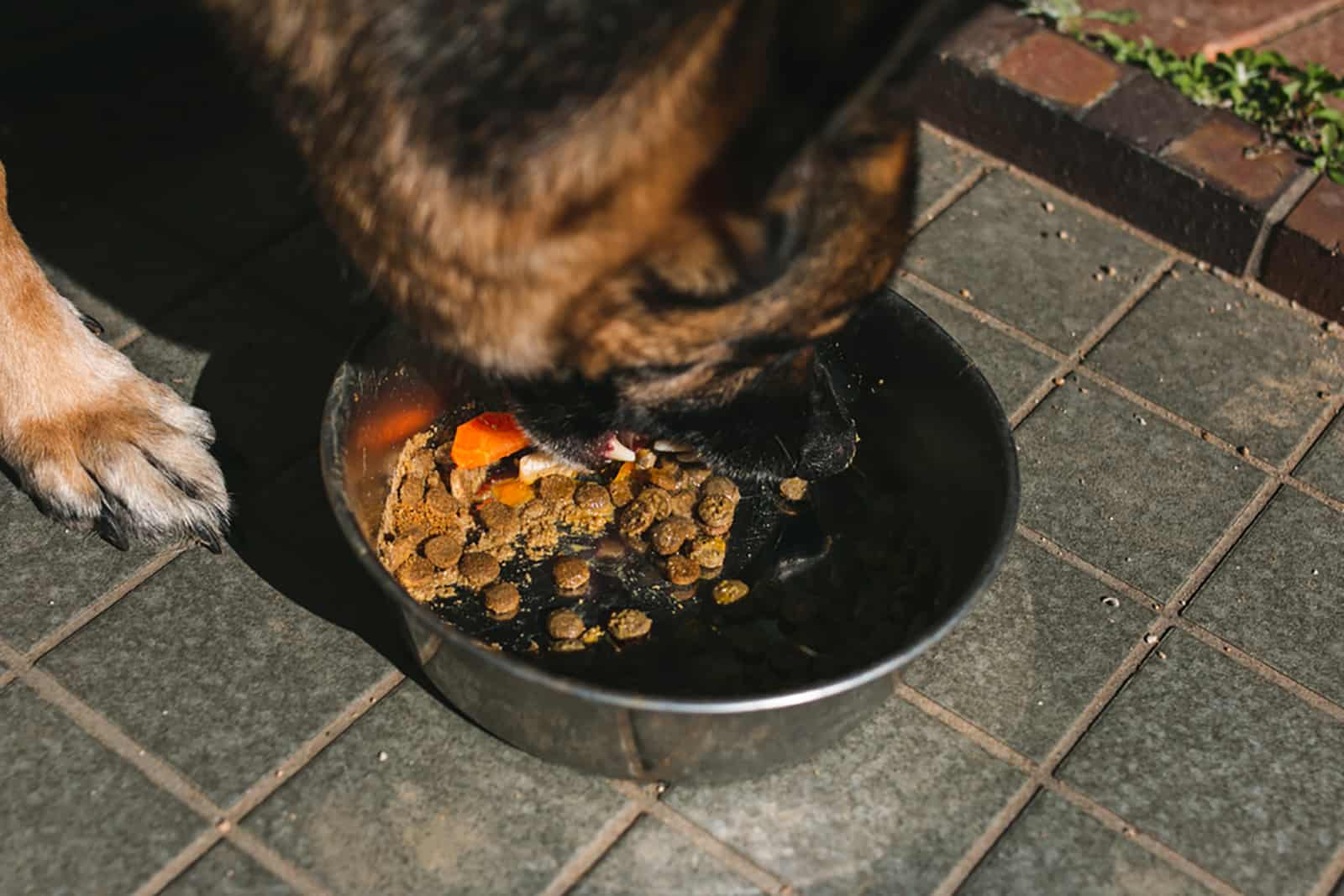
Every breed is different and has its own dietary requirements based on its energy level, growth, lifespan, health condition, and other factors.
For example, you will notice that feeding charts for Cane Corsos, Pitbulls, Great Danes, Shiba Inus, and other breeds are quite different, but they do have something in common, and that is the need for a nutritious, fulfilling, and healthy diet.
Several factors will help you determine which food is suitable for your GSD for an optimal balance of nutrients and energy providers.
Size
According to the American Kennel Club’s (AKC) breed standard for German Shepherds, the height of this large breed dog usually goes up to 26 inches.
However, there is a slight difference between male and female German Shepherds, so females usually grow up to 24 inches.
It’s possible for females to weigh anything between 50 and 72 pounds, while male canines mostly weigh anywhere from 65 to 90 pounds.
This indicates that both genders have a large appetite, which is why it’s even more important to feed them high-quality food that doesn’t include a huge amount of carbohydrates.
Age
Because of its high activity level and huge physique, the German Shepherd requires careful consideration about the optimum nutritional requirements at each phase of its growth.
These canines go through great changes during their first year of life, and all of these changes need to be followed by a proper diet.
If your pup is not receiving enough nutrients during mealtime, it might impact their overall health and slow down their development process, which could result in physical health issues (like problems with their joints).
Level Of Activity
Energy level is important in determining how much food your pet needs.
It’s natural that fiercely energetic dogs require a greater calorie intake than those who prefer spending time lying around or sitting on their owner’s lap all day.
The fact that German Shepherds are active, sturdy, and agile adds to the need for shifts in their diet as they grow up.
If you provide your pet with good quality food, there will be no reason to feed them outside their feeding schedule, but you might need to add a little more food if your vet confirms.
Health
Since GSDs are predisposed to numerous ailments, eating well is the best way to avoid complications.
A healthy diet, for instance, has the potential to lessen the severity of physical health issues brought on by conditions such as hip and elbow dysplasia.
Make sure that the diet you follow for your GSD includes all sorts of healthy stuff, including vitamins, proteins, fats (like fish oil), carbs, and minerals.
Giving A German Shepherd Puppy Supplements
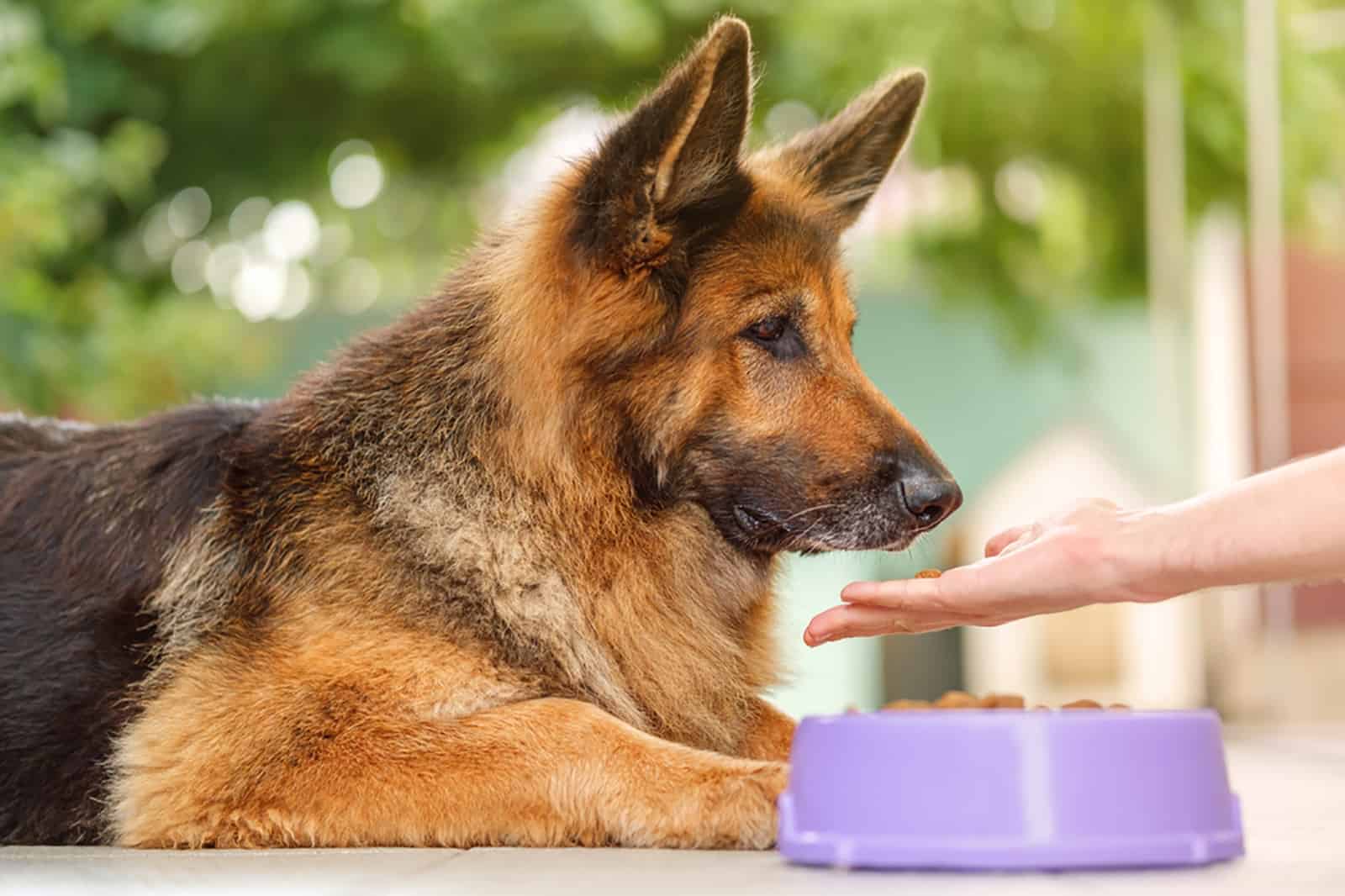
I’m sure you often come across canine supplements that are marketed as an essential addition to your dog’s diet.
These supplements are usually found on shelves with healthy food, which is why most people buy them.
However, are these really necessary for your German shepherd pup?
If you feed your dog with a good amount of nutrients during their mealtime, it’s highly unlikely they will need any type of supplements.
Of course, it is always recommendable to consult your vet about whether you should give your pet additional supplements or not.
Vitamins and minerals are excellent for canines’ physical and mental health. For example, vitamins E and A are great for canine skin and their immune system.
Magnesium is also essential for the development of muscles, along with other minerals that keep the brain, heart, and bones (calcium) in perfect condition.
However, all of these can be detrimental to your pet’s health if they are taken in excessive amounts.
This is one of the primary reasons why supplements are not recommended without prior consultation with a veterinarian.
The best way for them to decide whether your pet needs supplements or not is for you to bring the packaging of the food your canine is consuming with you.
This way, the vet will know if any supplements are needed at all.
What Kind Of Food Should GSDs Consume?
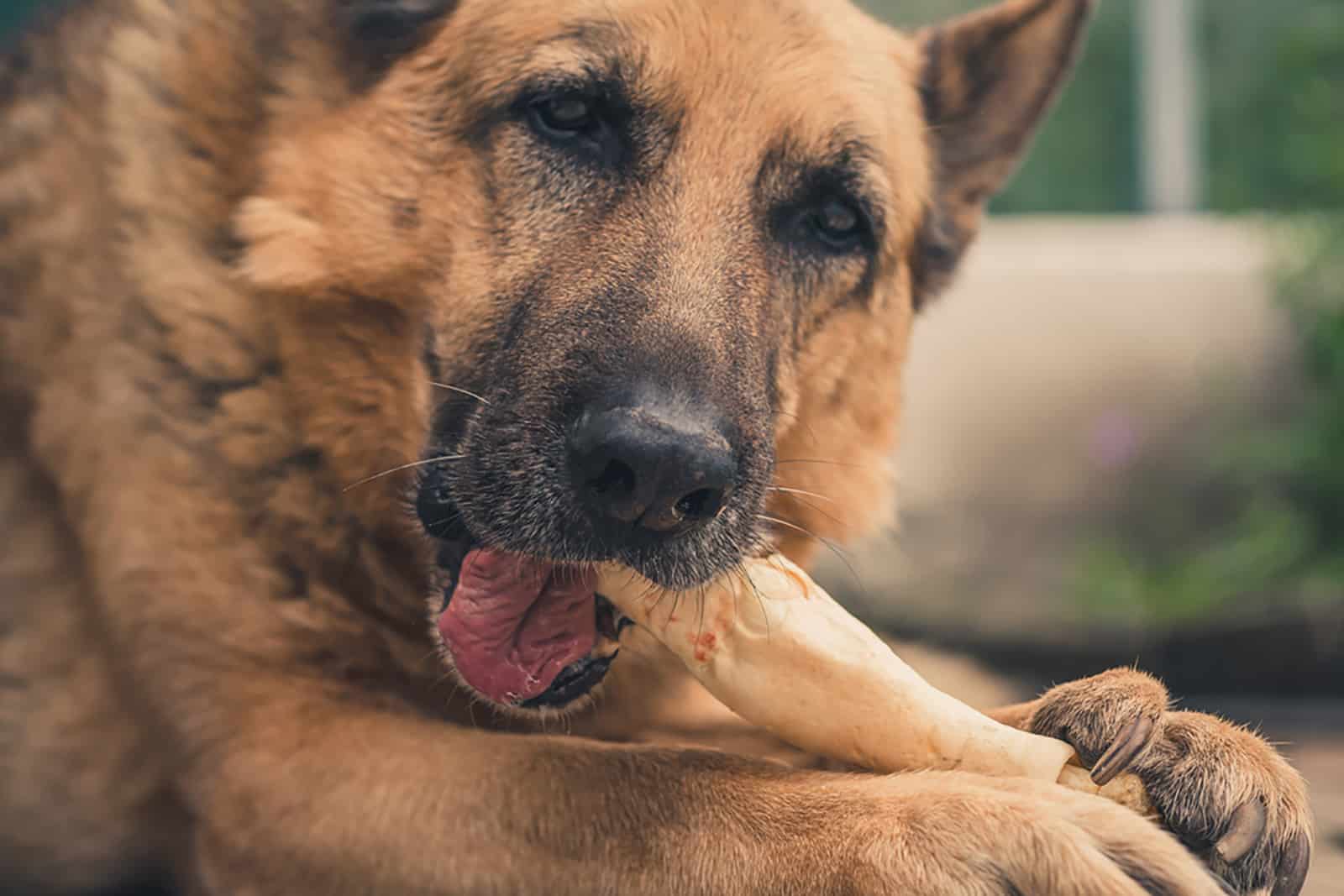
One thing that has been pretty much covered so far is the fact that all GSDs need food that contains plenty of ingredients with high nutritional value.
However, there are many types of food that people consider perfect for their development.
Not everyone is actually aware of what types of food there are, which is why we decided to categorize them, at least in a broad way, just to help you get the feeling of what food might be good for your GSD pet.
The fact that the food is nourishing and good for your dog’s health is the most crucial thing, regardless of which type you go for.
It is highly recommended that you seek the advice of a veterinarian in order to provide your GSD with food that is optimally suited to the lifestyle it leads.
To assist you in resolving this issue, the following is a list of potential dietary choices for your GSD puppy that you might wish to take into consideration:
Dry Food
Dry dog food (famously known as kibble), is industrial food for canines that is easily accessible and contains everything that your pup could possibly need.
It is inexpensive, simple to store, and does not go bad quickly. All you need to do is go to the store (or shop online), and your canine’s food is ready.
However, it’s essential to check the nutritional value of each dry food product before giving it to your pup.
The best way to know whether a certain brand of food provides a balanced diet for your pup is to check the nutritional label on every packet.
Dry meals are recommended for adult canines for many reasons, including oral health, as they help clean the dog’s teeth, bite practice, etc.
However, as the name says, this food is dry, which is why you should provide fresh water near the food bowl all the time to satisfy the dog’s need for hydration.
Home-Cooked Meals
Some dog owners are just not into giving their pups any type of industrial, commercial, or raw type of food, which is why they prefer to cook their own food for their furry companions.
Home-cooked food does have plenty of benefits for the digestive system and the development of canines in general.
However, if you’re planning to cook on your own, it’s important for you to learn and understand different groups of ingredients and how they might impact your pup’s well-being.
Some ingredients might not be suitable for German Shepherds, even though they cause no trouble to humans. We will discuss these foods later in the article.
Wet Food
Canned food for canines is usually wet food that can’t be stored in any other way to remain fresh for a longer period of time.
Essentially, this type of food is perfect for owners who don’t have the time to cook for their pets but would like their canines to eat meals that contain water rather than kibble.
On the other hand, this type of food can be combined with dry kibble to create a more hydrating and balanced meal for your pooch.
These types of commercial meals are not only costly but also easily get rancid, and if offered to your dog on their own, they very well may not be sufficient.
BARF Diet
Raw meat, raw eggs, animal bones, fruits, vegetables, probiotics, and other natural nutrients are the staples of this type of diet, which is also known as the “raw food diet.”
The raw diet is utilized as an alternative to the consumption of processed meals that include preservatives.
However, before feeding your dog raw food, you should get the advice of your veterinarian to prevent giving your pup microorganisms and bacteria that could make their stomach upset.
What Food Should Be Avoided In GSDs Diet?
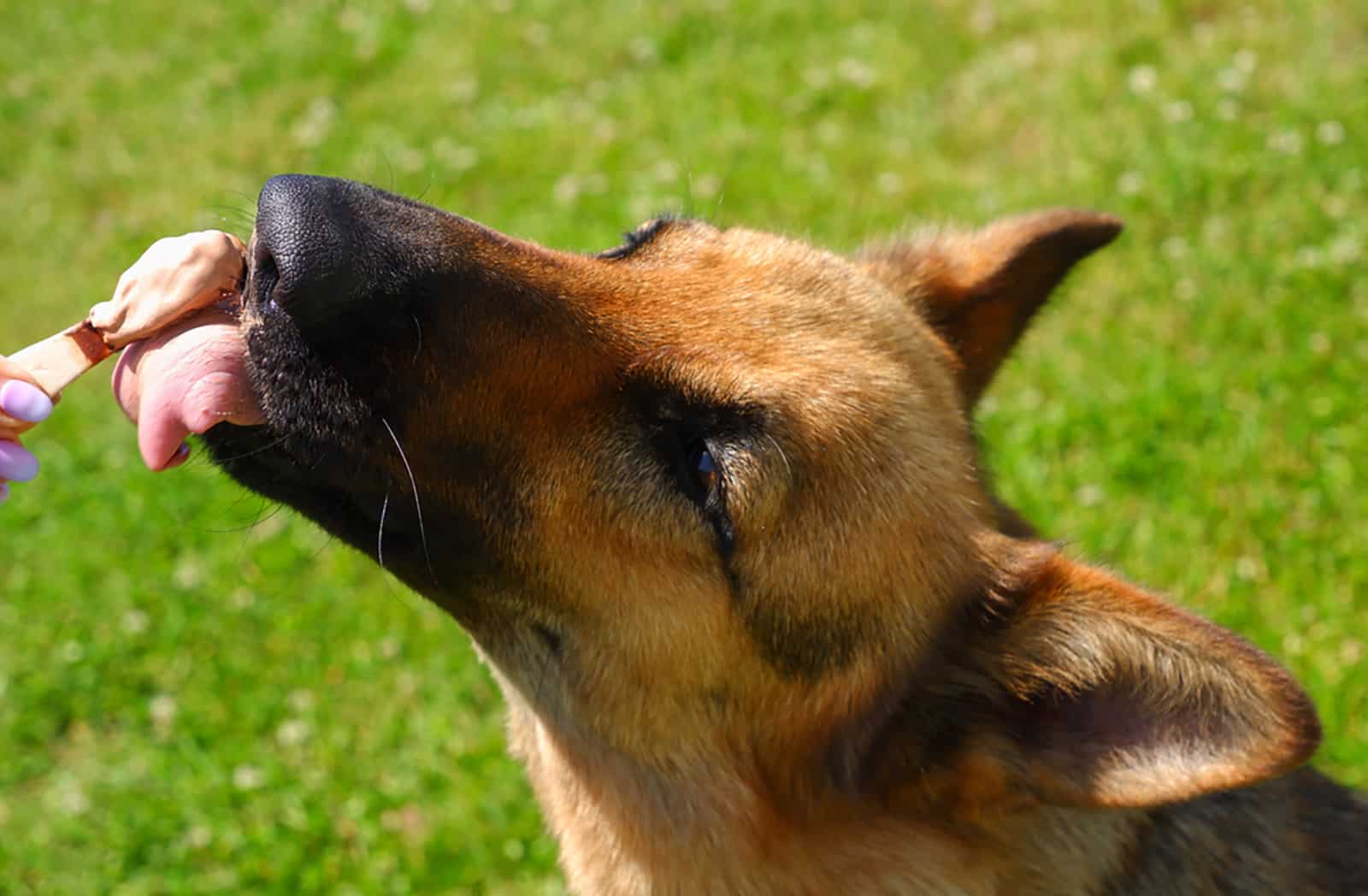
Up to this point, you might have concluded that German Shepherds really love to eat.
They’re not picky eaters at all, which is why you need to monitor them all the time and prevent them from eating something that might have a negative effect on their health.
One thing is for sure, your floors will always be clear from food because they’ll get everything that drops during a family meal.
That is why it’s essential for German Shepherd dog owners to learn which types of food should never be devoured by their four-legged friends, even if they give that cute puppy look.
In general, they may not be very sensitive to the food they come across; yet, some ingredients might prove to be lethal for them.
Chocolate
This type of food is proven to be toxic not only for German Shepherd canines but for the majority of dog breeds. One of the main reasons is sugar, which is unhealthy for humans, let alone for dogs.
Another reason that some owners aren’t familiar with is that chocolate contains theobromine, which has a negative impact on the canine’s metabolism and their body in general.
Coffee
This type of drink might be a favorite among humans, but it’s a big no-no for doggies, and it might be even life-threatening for them.
Caffeine has been linked to a great number of health problems, including elevated blood pressure, convulsions, arrhythmia and other cardiovascular issues, vomiting, etc.
If you’re a coffee enthusiast, you need to make sure you have a safe spot to keep the coffee away from your pet as much as you can.
Xylitol
This ingredient is one of the reasons why GSDs shouldn’t have any types of sweets, even those that say no sugar added, as they may have this sugar substitute in the ingredients list.
Certain types of peanut butter, gums, candies, and sugar-free chocolates contain this ingredient, which is actually a sweet type of natural alcohol.
This ingredient usually causes hypoglycemia, as well as seizures, lethargy, bloating and vomiting, and weakness in general.
Alcohol
This probably doesn’t need much explanation, but alcohol definitely deserves to be on the list.
Any type of alcoholic beverage is toxic for canines because their metabolism cannot process it.
It can cause respiratory problems, as well as low body temperature, fainting, vomiting, and other more serious symptoms, which can result in an abrupt end of their life.
Health Issues Related To The Type Of Food Or Improper Feeding Routine
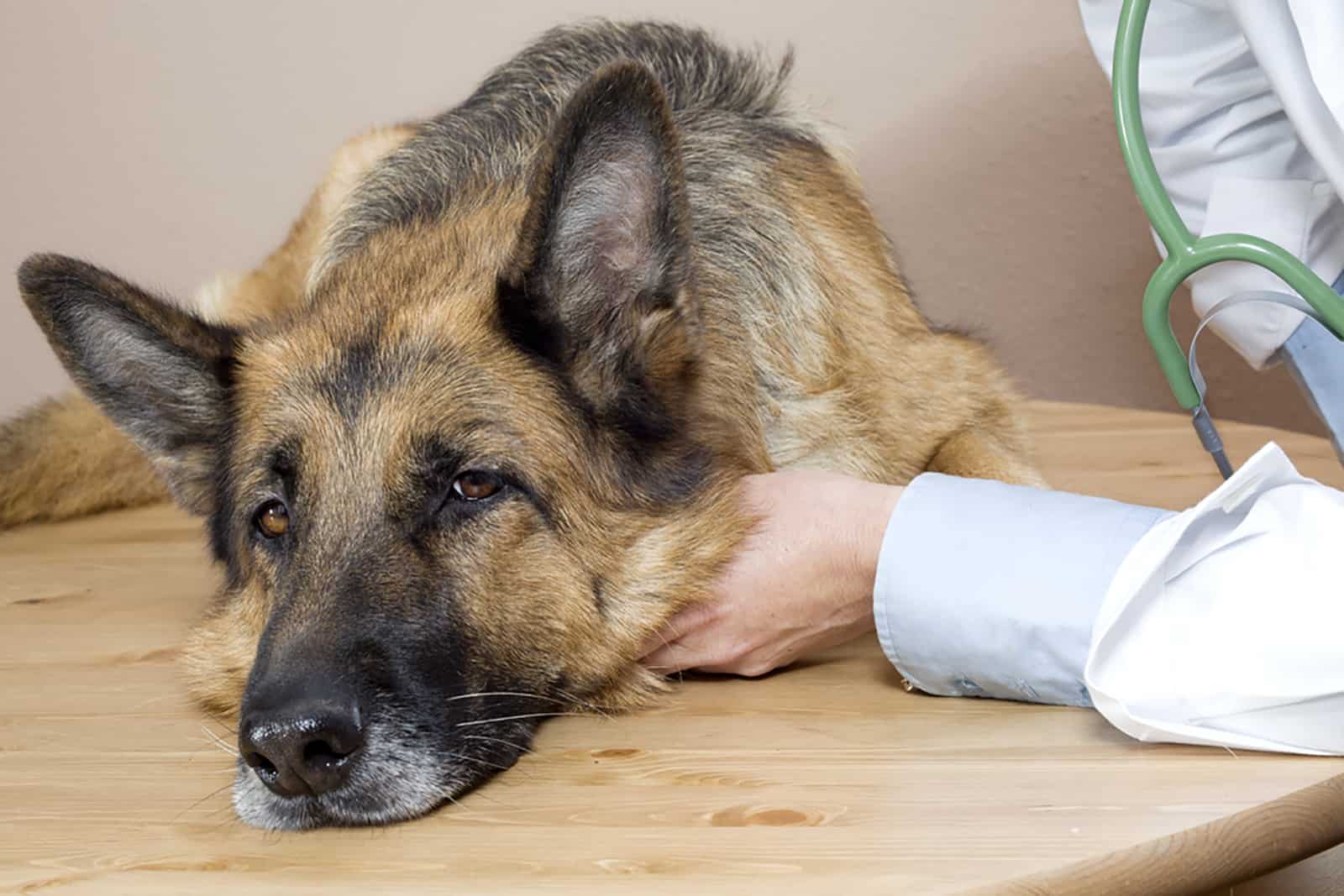
Diet plays an important role in the well-being of German Shepherds, whether as the main cause of the issue or an enhancer of existing symptoms.
Needless to say, it’s important to get German Shepherds from reputable breeders, as they’re the only ones who can guarantee that your pup will have the lowest risk of getting a genetic disease.
On the other hand, many health issues, particularly orthopedic illnesses, may be prevented by ensuring that your pet receives the appropriate nutrition and by feeding your pup the best dog food for their age and activity level.
The health conditions listed below are some of the most common diseases related to your canine’s diet:
• Hip Dysplasia – This is one of the most common joint conditions that can appear during puppyhood but show only in later years.
One of the possible reasons could be a lack of calcium during the early feeding of pups, along with their genetic background.
• Diabetes – Essentially, this condition represents a lack of insulin to take care of the glucose that enters the body. Diabetes might not be directly impacted by diet, but obesity and metabolic disorders can be one of the main culprits for this condition.
• Degenerative Disc Disease – If the canine’s spinal discs are ruptured, the pup will be unable to move without feeling great pain. Even though this condition isn’t caused by food, improper diet and obesity can worsen symptoms significantly.
• Gastric Dilatation-Volvulus – This is one of the most common disorders in large-breed canines because they’re believed to have a deeper chest.
Dogs that have larger servings of food are more prone to this condition than pups who have smaller meals.
• Exocrine Pancreatic Insufficiency (EPI) – If your dog suffers from EPI, it means that the enzymes from their pancreas aren’t able to process proteins, carbs, or fats, even healthy ones.
They can’t absorb enough nutrients and can become dangerously underweight.
• Renal Issues – Kidney issues usually happen because of intoxication, which is mostly related to bad food. Kidney failure is one of the most serious consequences of this condition.
Read More: Why Does My German Shepherd Lay Down To Eat? 9 Reasons
Which Human Food Is Recommended For GSDs?
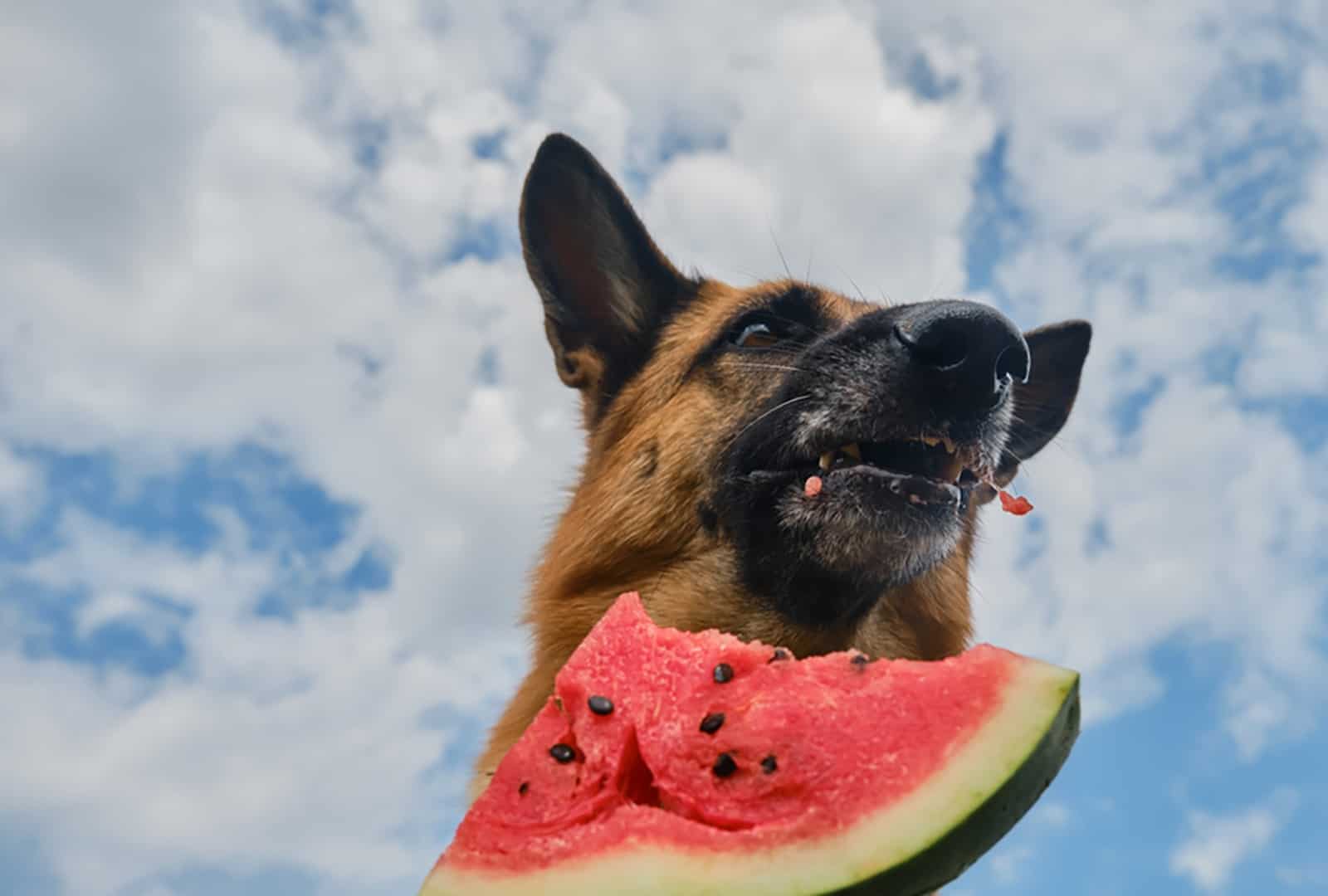
The bellies of both young puppies and adult doggies are very delicate and prone to gastrointestinal issues, which is why you need to be extra careful with offering them any new food, especially ones that humans consume.
It’s okay to sometimes give your pet a treat that is actually human food, but you need to be careful about it. The foods they can digest are often great sources of protein and nutrients but should still be taken with caution.
For instance, meat like beef, chicken, fish, and turkey are all excellent sources of protein that can aid in the development of muscular growth in your puppy, just as much as eggs.
In addition, there are many varieties of healthy fruits and vegetables that are excellent providers of vitamins, such as:
• Mangos
• Green peas
• Blueberries
• Peppers
• Carrots
• Cucumber
• Watermelon
• Apples
• Bananas
• Coconut
• Broccoli
• Strawberries
Which Human Food Isn’t Recommended For GSDs?
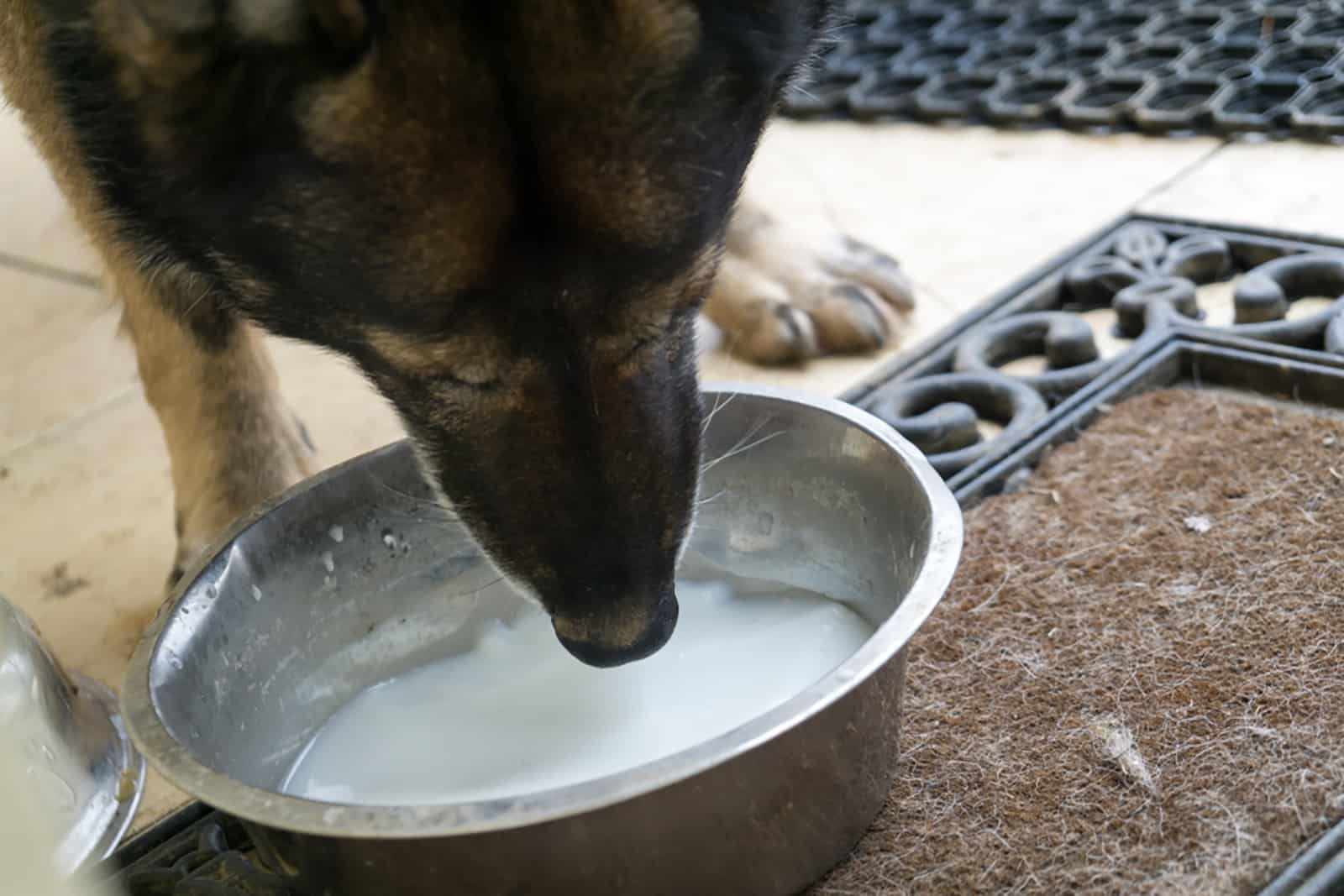
On the other hand, don’t be surprised if you come across certain foods that aren’t recommended for your GSD pup.
These foods might be completely safe for you and even desirable for humans because of their health benefits, but it doesn’t necessarily mean they’re good for your pet as well.
Actually, some groceries might have an extremely negative impact on your pup’s health, and could lead to intoxication, vomiting, diarrhea, bloating, lethargy, etc.
The following are examples of foods that shouldn’t be on your pup’s menu, no matter how old they get:
• Dairy
• Onions and garlic
• Grapes
• Macadamia nuts
• Fruit pits
• Raisins
• Chocolate
• Avocado
Some of these are already well-known as foods that are prohibited for canines, but certain groceries are still widely accepted as good options for pups, even though they might trigger serious health conditions.
Wrapping Up
Keeping your pet healthy is surely one of your main concerns, and this German Shepherd feeding chart is exactly what you need to keep your pup’s health in perfect condition.
A German Shepherd’s diet is crucial for their development and health throughout life. No matter which type or color your GSD is, it requires the same amount of care.
You can go for commercial food such as Royal Canin, Purina Pro, Science Diet, and others, or cook for your pet yourself.
The only thing that matters is that you’re providing your pooch with all necessary nutrients, including vitamins, carbs, and minerals.
READ NEXT:
Are German Shepherds Good With Cats? A Guide You Need To Read
15 Best Dog Food For German Shepherds: Top Yummy Choices Your GSD Will Adore!
